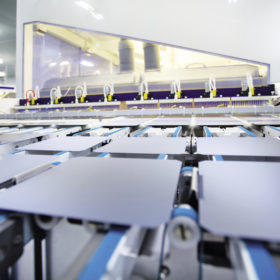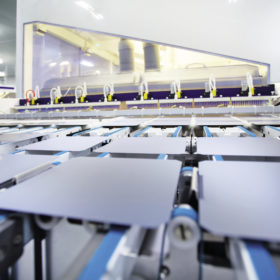Chinese PV Industry Brief: Financials, a new GW-scale factory, and big hydrogen

Longi and Sungrow both announced solid financial results last week. Module maker China Solar delayed the resumption of trading on the Hong Kong stock exchange, and polysilicon producer GCL-Poly unveiled plans to raise up to US$16.8 million by issuing shares. Coal miner Baofeng Energy, meanwhile, announced the construction of what it claims will be the world’s largest PV-powered hydrogen plant, and Seraphim and Lu’An Solar revealed that they will open a 5 GW PV panel factory in China’s Jiangsu province.
Today’s Chinese PV Industry Brief will be the first in a series of updates on China’s solar manufacturing sector and downstream PV market. It will be published every Tuesday and Friday and will include new developments from solar companies listed on the Hong Kong, Shenzhen and Shanghai stock exchanges, as well as PV-related news from non-listed players, the Chinese government, and regional authorities throughout the country.
Longi Green Energy Technology announced solid financial results last week, as the monocrystalline module manufacturer published its earnings for fiscal 2019 and the first quarter of this year.
Last year, it recorded revenue of RMB32.9 billion ($4.65 billion), up 49.6% from 2018. Net profit increased 106.4% year on year to reach RMB5.28 billion. Its figures for the first quarter of 2020 maintained the positive trend, with revenue reaching RMB8.6 billion, up 50.6% year on year, and net profit hitting RMB1.86 billion, up 204.9% on the year. Gross margins for 2019 and the first quarter of 2020 were 31.7% and 31.9%, respectively, while its operating net cash flow in 2019 reached RMB8.16 billion, up 595.3% year on year.
Sales revenue from Longi’s wafer business hit RMB12.91 billion (up 111.1% year on year) in 2019, while its total wafer shipments reached 58 GW. Average selling prices were about RMB2.75 per piece, down 11.7% from the preceding year.
Longi’s PV module business achieved a turnover RMB14.57 billion, up 11.3% year on year. Total shipments hit 8.36 GW, with 7.39 GW shipped to external clients and 971 MW allocated to the group’s self-consumption PV projects. It sold around 67% of its modules in overseas markets, pushing its global market share up to 7% in 2019. For 2020, the manufacturer expects shipments to reach 17 GW.
At end of 2019, its total wafer and module capacity reached 42 GW and 14 GW, respectively. By the end of this year, the company expects them to grow to 75 GW and 30 GW, respectively.
Chinese inverter maker Sungrow also released its earnings for 2019 last week. Its revenue increased 25.4% year on year to around RMB13 billion, while its net profit jumped 10.2% to RMB893 million. The company recorded total inverter shipments of 17.1 GW, with a slight increase of 2.4% compared to 2018. Domestic sales accounted for 30% of total sales with a share of 8.1 GW and a year-on-year drop of 31.9%. Overseas sales hit 9 GW, up 87.5% year on year, pushing its global market share to around 15%.
Revenue from Sungrow’s EPC business reached RMB7.94 billion, with year-on-year growth of 35.1%. Last year, it deployed about 3.17 GW in this segment. The company downwardly revised its net profit forecast for 2020 and 2021 to RMB1.02 billion and RMB1.18 billion, respectively, due to the negative impact of the Covid-19 crisis. Prior to the spread of the pandemic, Sungrow was anticipating a net profit of RMB1.14 billion for 2020 and RMB1.24 billion for 2021.
TBEA Co., Ltd., which is active in the solar sector as an inverter provider and EPC developer, saw its total revenue and profit decline slightly last year. The company registered a turnover of RMB37 billion, down 6.75% from 2018, with net profit dropping by just 1.4% to RMB2.02 billion. Last year’s revenue also includes non-solar related businesses. The Xinjiang-based group also reported that it shipped 1.8 GW of inverters and produced 37,000 tons of polysilicon last year.
China Solar said on Monday that its plan to finally resume trading of its shares – which have been suspended from the Hong Kong exchange since August 2013 – has been interrupted by the Covid-19 outbreak.
GCL New Energy said on Wednesday that attendees to a crucial shareholder vote, planned for May 21 in Hong Kong, will have to bring their own face masks, with obligatory temperature testing to be conducted. Shareholders will vote on whether to approve the proposed RMB851 million sale of seven PV projects to Chinese state-owned electric utility China Huaneng. The Chinese solar project developer says the sale could add RMB2.66 billion to its balance sheet. The news came a day after parent company GCL-Poly announced plans to raise up to HK$130 million (US$16.8 million) by issuing shares.
Baofeng Energy, meanwhile, said last week that it has started building what it claims will be the world’s largest solar-powered hydrogen plant, in northwestern China’s Ningxia region. The Chinese coal miner said the project will feature two 10,000m3/hr electrolyzers powered by two 100 MW solar plants, plus a 1,000kg/day hydrogenation station. In addition, it will feature two petrol stations that will be converted to supply natural gas and hydrogen for transport purposes.
And finally, Seraphim and Lu’An Solar announced this week that they will open a 5 GW PV panel manufacturing plant in the Jiangsu Yixing Economic Development Zone, in China’s Jiangsu province. The factory will be part of the 2020 Yixing Major Projects to Build a New Energy Industry Highland, which is expected to spur industrial development in the county. The project will involve a total investment of RMB12 billion, the two solar manufacturers said.


